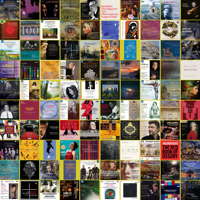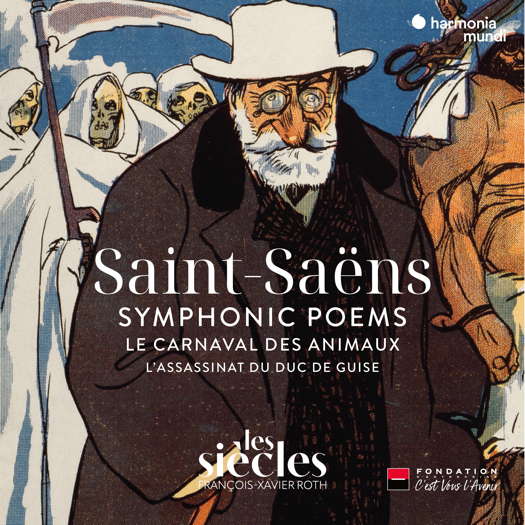- Wanda Wiłkomirska
- Marcello Giordani
- symphonic winds
- bassoon music
- David Alden
- Puccini: Gianni Schicchi
- Anthony Cheng
- Daron Hagen
 UPDATES: There's a new feature every day at Classical Music Daily. Read about the various ways we can keep in touch with you about what's happening here.
UPDATES: There's a new feature every day at Classical Music Daily. Read about the various ways we can keep in touch with you about what's happening here.
 LISTENING TO TCHAIKOVSKY: Béla Hartmann uses his knowledge of Eastern Europe to argue against the banning of all Russian culture following Vladimir Putin's invasion of Ukraine.
LISTENING TO TCHAIKOVSKY: Béla Hartmann uses his knowledge of Eastern Europe to argue against the banning of all Russian culture following Vladimir Putin's invasion of Ukraine.

A Glorious Listening Experience
Seven orchestral works by Camille Saint-Saëns, warmly recommended by GERALD FENECH
'... a thrilling and vibrant journey of melodic invention.'
French composer Camille Saint-Saëns (1835-1921) was a musical prodigy and made his concert debut at the age of ten. After studying at the Paris Conservatoire he followed a conventional career as a church organist in several important churches, such as Saint-Merri and La Madeleine. After spending twenty years in this assignment, he left to become a successful freelance pianist and composer, in demand in Europe and the Americas.
As a young man, Saint-Saëns was enthusiastic for the most modern music of the day, particularly that of Schumann, Liszt and Wagner, although his own compositions were generally within a conventional classical tradition. This brought him into conflict in his later years with composers of the impressionist and expressionist schools of music, although there were neoclassical elements in his music, foreshadowing works by Stravinsky and Les Six. He was often regarded as a reactionary in the decades around the time of his death in 1921.
Saint-Saëns lived a long life so, as expected, his catalogue of works is as broad as it is varied. He composed for all genres and forms, but this superb issue focuses on just seven of his orchestral works. Three are very popular, another three only enjoy average interest, but one is, to all intents and purposes, a veritable rarity.
Though Berlioz and to a lesser extent Franck wrote symphonic poems, it is Saint-Saëns who has been largely credited with introducing the genre to France. A wide orchestral palette and stirring reserves of drama are used to evoke the youthful audacity and death of the eponymous Phaéton, Op 39 (1873), the ultimate triumph of virtue over pleasure in La Jeunesse d'Hercule (Hercules' Youth), Op 50 (1877) and Hercules' punishment, spinning wool while dressed as a woman, for the inadvertent murder of one of his friends in Le Rouet d'Omphale (Omphal's Spinning Wheel), Op 31 (1869).
Listen — Saint-Saëns: Le Rouet d'Omphale
(HMM 902614.15 CD1 track 3, 0:00-0:59) ℗ 2023 harmonia mundi musique sas :
The ever popular Danse macabre, Op 40 (1874), is a spooky depiction of Death playing a dance on his fiddle on a tomb in a graveyard surrounded by skeletal dancers.
The opera Samson et Dalila is the only work that has retained popularity from the numerous other operas and ballets that the composer wrote for the stage. The piece took almost nine years to be completed, but following its premiere by Franz Liszt in Weimar in 1877, it never looked back. The opera is a dazzling virtuoso piece, both vocally and orchestrally, and is admired for its combination of brilliant sound and dramatic emotion. These qualities are very evident in the famous Act III Bacchanale, the orgiastic percussion-driven dance that preceeds Samson's destruction of the Philistine Temple. In François-Xavier Roth's hands it is indeed explosive.
Listen — Saint-Saëns: Bacchanale (Samson et Dalila)
(HMM 902614.15 CD1 track 5, 2:41-3:40) ℗ 2023 harmonia mundi musique sas :
Following a disastrous concert tour of Germany in 1885-86, Saint-Saëns withdrew to a small Austrian village, where he composed The Carnival of the Animals in February 1886. From the beginning he regarded the work as a piece of fun, and since its publication in April 1922 and its first public performance on 25 February of that same year, it has delighted listeners of all ages and remains one of the composer's most popular works. What about the music itself? The critic of Le Figaro reported thus:
From the first note to the last it is an uninterrupted outpouring of a spirit of the highest and noblest comedy. In every bar, at every point, there are unexpected and irresistible finds ... When he likes to joke, the master never forgets that he is the master.
Listen — Saint-Saëns: Le Coucou au fond des bois (Le Carnaval des animaux)
(HMM 902614.15 CD2 track 9, 0:00-0:47) ℗ 2023 harmonia mundi musique sas :
The best for the last. With the advent of silent pictures, a technical revolution occurred that was to change the form of entertainment forever. In 1907 Paul Lafitte, a wealthy novelist, publisher and financier, founded 'Le Film d'Art' to produce French films which he hoped would gain the admiration of the cultural elite as well as the patronage of the common people. His baptism of fire came in 1908 with L'Assassinat du duc de Guise, a French historical drama lasting just eighteen minutes. The film was a resounding critical success which opened the gates for an incessant flow of other productions.
At this stage you might be asking where does Saint-Saëns fit in? Well the composer was commissioned to write the music required to support the action on screen and, fascinated by this opportunity to break new ground, he accepted wholeheartedly. He was provided with a finished version of the film and, after viewing its scenes several times, Saint-Saëns composed an introduction and five distinct tableaux to support its narrative.
He was not afforded a large budget and, consequently, he hired a small chamber ensemble. Saint-Saëns chose to utilize leitmotifs to support the identities of the two main characters and, using this method, he was also able to focus on the film's characters, imagery and narrative with more intensity. Saint-Saëns' music for this film served as a seminal event in the history of film score art, in that it represents the inaugural effort to support a film's narrative with originally descriptive music, paving the way for those overpowering scores that were to come later, when cinematic art became what it is today.
Listen — Saint-Saëns: Quatrième tableau (L'Assassinat du duc de Guise)
(HMM 902614.15 CD2 track 19, 1:22-2:21)
℗ 2023 harmonia mundi musique sas :
Roth's conducting of Les Siècles is a glorious listening experience, where his brisk tempi and fire and brimstone approach make of this disc a thrilling and vibrant journey of melodic invention. Irresistible music-making in fine sound and luscious presentation which I warmly recommend.
Copyright © 19 October 2023
Gerald Fenech,
Gzira, Malta



